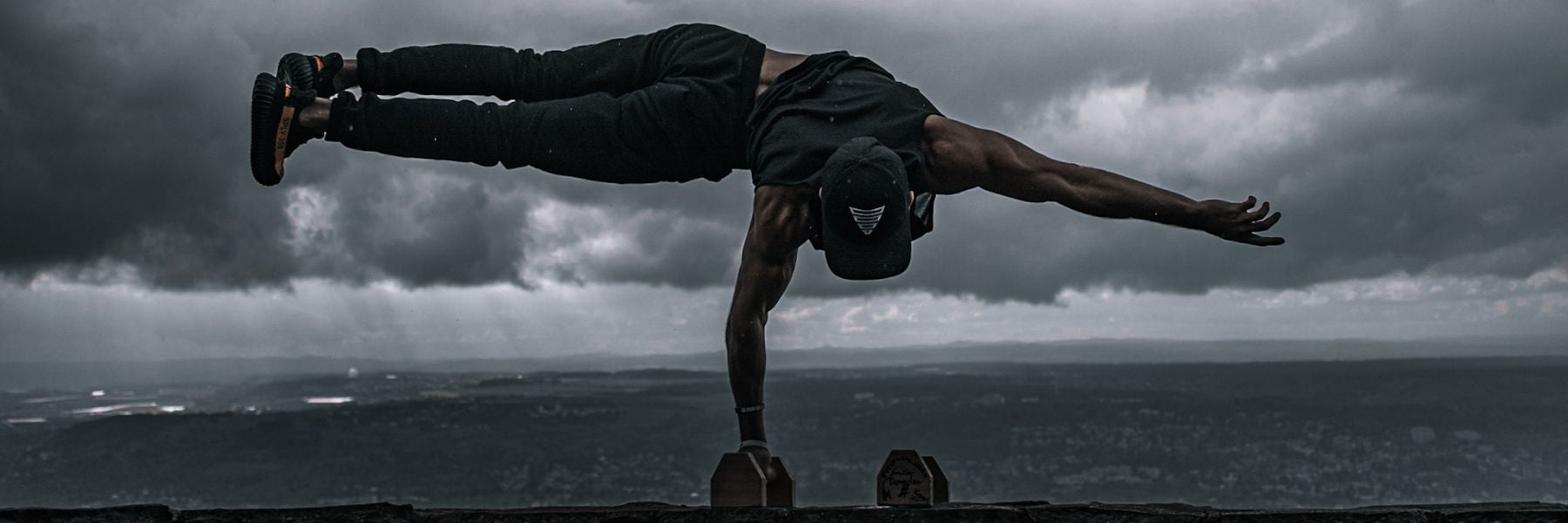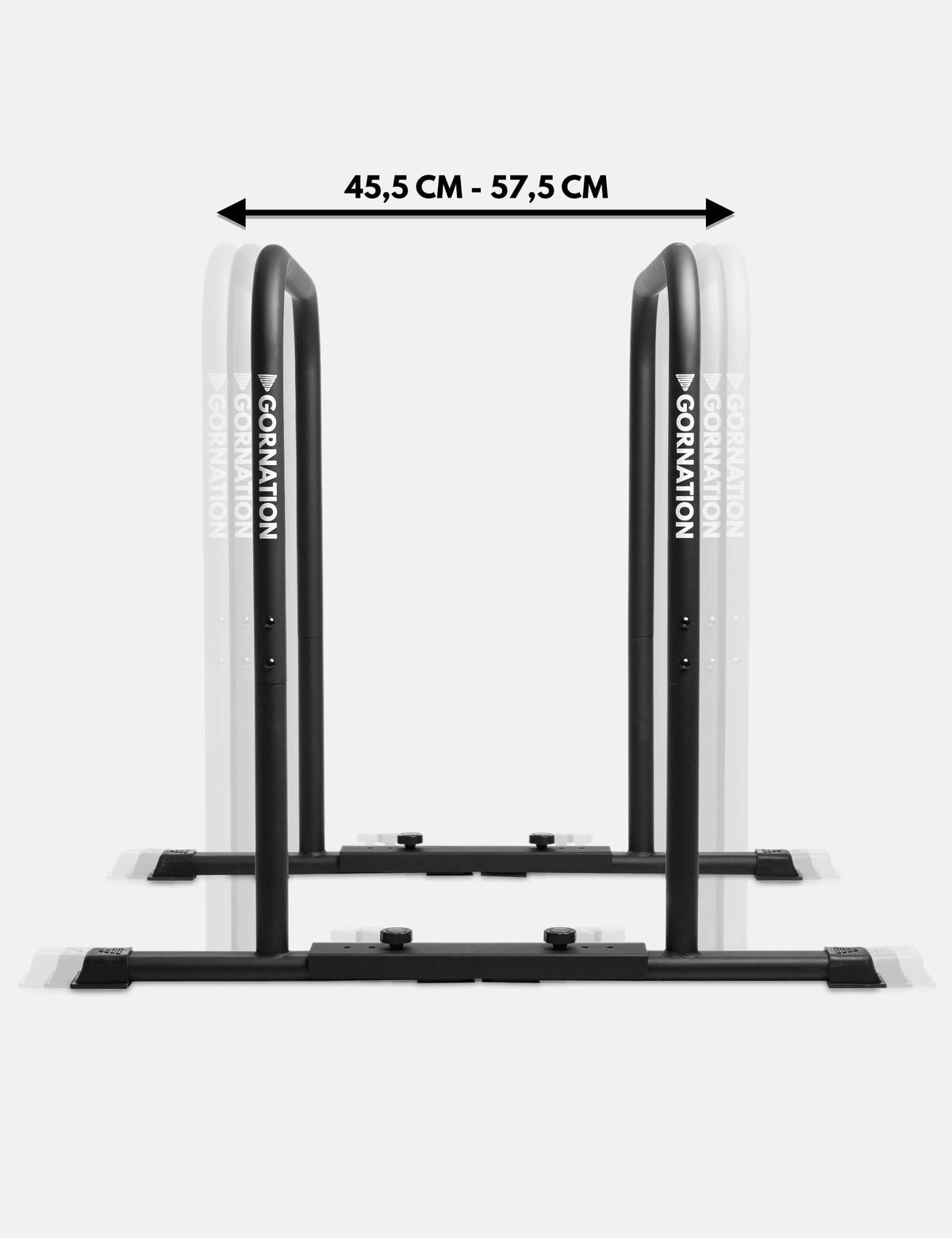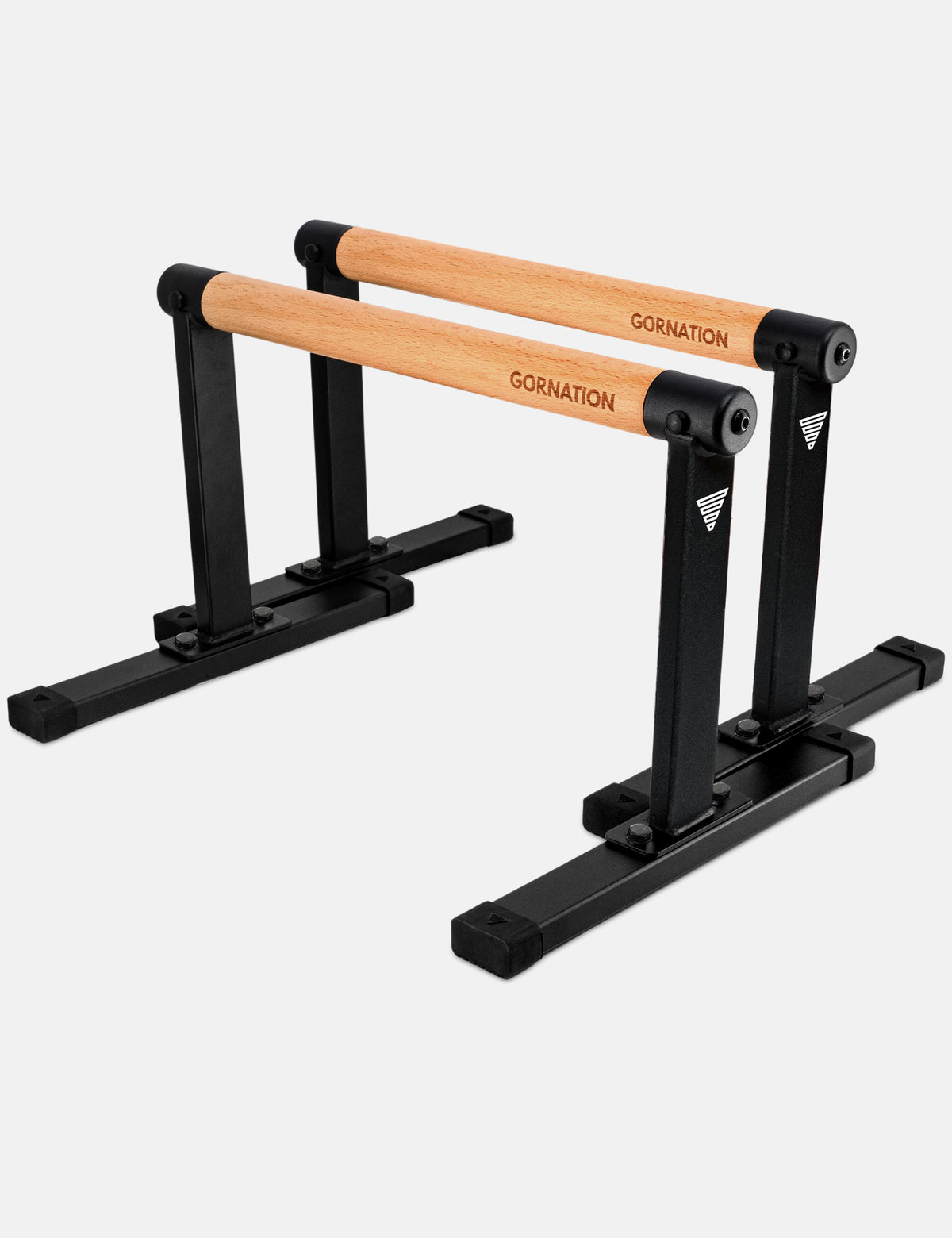13 Calisthenics exercises on parallettes - for beginners, intermediates and professionals
Parallel bars offer endless possibilities and are one of the most popular workout tools in gymnastics, calisthenics, functional fitness or crossfit. This blog article is designed to give you inspiration and ideas to better design your training plan and add new excitement through new exercises. The exercises are functional whole body exercises that not only activate one muscle group, but often many different groups are used at the same time like the gymnastic rings exercises. This offers advantages for functional strength building, fat burning and the development of strength endurance. Enough introduction, let's get to the exercises.
Exercise 1 - Incline Push Ups (beginners)
Incline Push Ups are push-ups in which the hands are not at the same height as the feet, but the hands are placed on a higher surface. This way there is more weight on the feet and less weight on the hands, which has to be moved and also beginners can learn push ups. The higher the hands, the easier the push-ups. Important: The elbows stay close to the body and bend backwards and not to the side. Choose the level of difficulty so that you can do clean repetitions.
Recommended Parallettes: MAX

Exercise 2 - Inverted, elevated bridge (beginners)
The inverted bridge is a good way to strengthen the shoulders, core (abdominal and back muscles) and triceps. Doing the exercise on parallel bars has the advantage that the wrists are relieved by the neutral position and injuries are prevented. Again, the higher the arms are placed, the easier the exercise becomes. Important: arms completely stretched, hips pushed up as far as strength and shoulder mobility allow.
Recommended Parallettes: ACTIVE or MAX

Exercise 3 - Bench Dips (beginners)
Bench dips are a popular exercise for beginners and advanced athletes to build a strong triceps and as an assistant exercise for push ups or dips. The exercise is also called Arnold Dips or Triceps Dips. Here again the principle applies that the higher the hands, the easier the exercise, because more weight lands on the feet. Important: Arms stretched out in the upper position, elbows bent backwards and not outwards. To make the exercise more difficult, either weight vest, weight plates on the legs or raising the feet can be considered.
Recommended Parallettes: MAX

Exercise 4 - Frog Stand (beginner to advanced)
The Frog Stand or in Yoga also called the "Crow", is a very good exercise to improve balance, establish intermuscular coordination and learn the handstand. For beginners the arms can be bent, for advanced athletes the goal is to stretch the arms completely and thus build up the "Straight Arm Strength" desired in Calisthenics. On the floor, the exercise leads to the extreme angle for the wrist and often to pain in it. Therefore it is advisable to do the Calisthenics exercise on parallettes. Important: Practice the exercise on a soft surface, because at the beginning you might fall over forwards.
Recommended Parallettes: ACTIVE or MAX

Exercise 5 - L-Sit (advanced)
The L-Sit is an aesthetic, beautiful exercise and uses many muscles in the upper body like shoulders, triceps, core (abdominal and lower back muscles) and even the legs are under tension. This exercise requires a certain amount of strength and mobility in order to perform it properly. It is one of the basics in calisthenics. Important: The arms should be stretched and the shoulder blades should be pulled down, so that you push yourself up and remain stable.
Recommended Parallettes: ACTIVE for advanced or MAX for beginners

Exercise 6 - Handstand (advanced)
The handstand is one of the most popular calisthenics exercises and creates one of the most beautiful combinations of strength and balance. It requires strength in shoulders, forearms and body tension and patience, as learning the exercise often takes longer than other exercises. The handstand on parallettes not only has the advantage that it is easy on the wrists, but it also has the advantage on the minibars that you can counter-steer as well as on the floor, if you overturn in front, and if you fall back to the starting position, you can pull on the parallettes. For this reason, parallel bars should not be missing during calisthenics training. Important: Make sure that you have a safe environment and at the beginning it is best to have a wall or a partner who offers you safety in case you fall over.
Recommended Parallettes: ACTIVE or PRO

Exercise 7 - Decline Push Ups (Advanced)
The partner of Incline Push Ups, which involve more of a push down movement, are Decline Push Ups. With this type of push-ups, Calisthenics athletes have the opportunity to build up their push power upwards and cover the angle between normal push-ups and pike push ups/handstand push ups. The exercise is much more demanding than the Incline Push Ups due to the elevation of the feet and the subsequent weight on the hands, but brings great benefits for chest, shoulder and triceps. Important: Keep the body under tension to avoid a hollow back and to build up the core that is often used for calisthenics and street workouts.
Recommended Parallettes: MAX

Exercise 8 - Pike Push Ups (Advanced)
They have already been cut and are one of the best ways to build functional shoulder strength in vertical push: Pike Push Ups. It is the best preliminary exercise for handstand push ups, but there are some things to consider. The arms are bent backwards and stay on the body. From this movement it follows that the head goes far forward and the nose does not touch the ground between the hands, as the exercise is often wrongly done, but further forward. Leaning forward strains the part of the body that we will need later for the HSPU (Handstand Push Up). Again, parallettes help to relieve the wrist, but also to vary with height and to have more ROM (Range of Motion) and to be able to go deeper. One of the must-do calisthenics exercises. Important: Legs stay straight, core remains active, beginners prefer to choose higher parallel bars to get more repetitions.
Recommended Parallettes: ACTIVE for advanced, MAX for beginners

Exercise 9 - Tuck Planche (advanced)
The full planche is later one of the king disciplines on the parallettes and needs months, if not years of training even for advanced calisthenics athletes. A good way to build functional shoulder strength with bodyweight exercises is the tuck planche or also called tucked planche. In this calisthenics exercise we start in the frog stand position, but take the legs between the arms and the core keeps the legs in the air. Important: Push out the shoulders (shoulder protraction) and provoke a hump, arms remain completely stretched.
Recommended Parallettes: PRO or MAX

Exercise 10 - Planche Leans (Advanced)
Planche Leans are a good way to learn the Straight Arm Strength before the Tucked Planche, which is needed for the different progressions of the Planche and the final exercise at the end. Also very important here: Protraction of the shoulders, means to make a hump and to push yourself out with your shoulders. Arms are stretched and Core is activated. Lean forward as far as it is comfortable for you and increase from week to week.
Recommended Parallettes: ACTIVE or PRO

Exercise 11 - Straddle Planche (professionals)
The Straddle Planche is one of the most popular calisthenics exercises and shows strength and hard training. A lot of shoulder strength is needed to lean forward far enough for the legs to leave the ground. In order for the arms to withstand this high load on the armpit, calisthenics athletes need a strong biceps and forearm in extension, which together are described as Straight Arm Strength. This strength is required for many calisthenics and gymnastics exercises, such as the Human Flag, Iron Cross or handstand. In addition, the Straddle Planche requires a strong core that can lift the legs and keep the body parallel to the ground. Mobility also plays a role in this exercise in hips and legs.
Recommended Parallettes: MAX for beginners in this exercise, PRO and ACTIVE for professionals

Exercise 12 - Full Planche (professionals)
The Full Planche is another great improvement on the Straddle Planche, as it requires even more force in the shoulders and arms to allow the body to lean even further forward. In addition, the performing calisthenics athlete needs an even greater core force to keep the legs in the air and a straight line parallel to the ground. Many athletes need the same amount of time from their first tucked planche to the straddle planche as they do later from the straddle planche to the full planche, because the exercise involves a large increase.
Recommended Parallettes: MAX or PRO

Exercise 13 - Maltese Full Planche (professionals)
The Maltese Planche is a variation of the Full Planche and means a wider grip of the bars. It shifts the power needed and for some very advanced athletes the Maltese Planche is even easier than the Full Planche. It requires the same muscle groups, but in a different ratio.
Recommended Parallettes: MAX or PRO

 | 5.000+ Reviews
| 5.000+ Reviews
 Free EU Shipping above 100€*
Free EU Shipping above 100€*
 Worldwide Tracked Shipping
Worldwide Tracked Shipping













